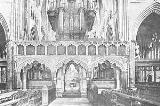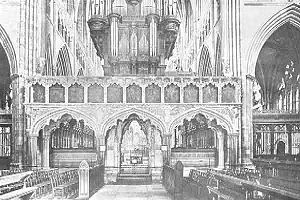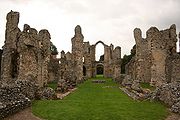
Pulpitum
Encyclopedia

Monastery
Monastery denotes the building, or complex of buildings, that houses a room reserved for prayer as well as the domestic quarters and workplace of monastics, whether monks or nuns, and whether living in community or alone .Monasteries may vary greatly in size – a small dwelling accommodating only...
architecture in Europe. It is a massive screen
Rood screen
The rood screen is a common feature in late medieval church architecture. It is typically an ornate partition between the chancel and nave, of more or less open tracery constructed of wood, stone, or wrought iron...
, most often constructed of stone, or occasionally timber, that divides the choir
Chancel
In church architecture, the chancel is the space around the altar in the sanctuary at the liturgical east end of a traditional Christian church building...
(the area containing the choir stalls and high altar in a cathedral
Cathedral
A cathedral is a Christian church that contains the seat of a bishop...
, collegiate
Collegiate church
In Christianity, a collegiate church is a church where the daily office of worship is maintained by a college of canons; a non-monastic, or "secular" community of clergy, organised as a self-governing corporate body, which may be presided over by a dean or provost...
or monastic church
Monastery
Monastery denotes the building, or complex of buildings, that houses a room reserved for prayer as well as the domestic quarters and workplace of monastics, whether monks or nuns, and whether living in community or alone .Monasteries may vary greatly in size – a small dwelling accommodating only...
) from the nave
Nave
In Romanesque and Gothic Christian abbey, cathedral basilica and church architecture, the nave is the central approach to the high altar, the main body of the church. "Nave" was probably suggested by the keel shape of its vaulting...
and ambulatory
Ambulatory
The ambulatory is the covered passage around a cloister. The term is sometimes applied to the procession way around the east end of a cathedral or large church and behind the high altar....
(the parts of the church to which lay
Laity
In religious organizations, the laity comprises all people who are not in the clergy. A person who is a member of a religious order who is not ordained legitimate clergy is considered as a member of the laity, even though they are members of a religious order .In the past in Christian cultures, the...
worshippers may have access). Typically the pulpitum is lavishly carved and decorated, and those of York Minster
York Minster
York Minster is a Gothic cathedral in York, England and is one of the largest of its kind in Northern Europe alongside Cologne Cathedral. The minster is the seat of the Archbishop of York, the second-highest office of the Church of England, and is the cathedral for the Diocese of York; it is run by...
and Canterbury Cathedral
Canterbury Cathedral
Canterbury Cathedral in Canterbury, Kent, is one of the oldest and most famous Christian structures in England and forms part of a World Heritage Site....
preserve complete medieval sets of statues of the Kings of England.
The word pulpitum is applied in ecclesiastical Latin both for this form of screen and also for a pulpit
Pulpit
Pulpit is a speakers' stand in a church. In many Christian churches, there are two speakers' stands at the front of the church. Typically, the one on the left is called the pulpit...
; the secular origin of the term being a theatrical stage, or speaker's dais. It is thought that this form of screen originated in monastic practice, providing a raised stage from which members of a religious communities could address pilgrims
Pilgrims
Pilgrims , or Pilgrim Fathers , is a name commonly applied to early settlers of the Plymouth Colony in present-day Plymouth, Massachusetts, United States...
attending to venerate the church's relics, while still maintaining their monastic seclusion from lay contact.

Organ (music)
The organ , is a keyboard instrument of one or more divisions, each played with its own keyboard operated either with the hands or with the feet. The organ is a relatively old musical instrument in the Western musical tradition, dating from the time of Ctesibius of Alexandria who is credited with...
. The pulpitum is invariably pierced by a central passage, leading immediately into the choir stalls to the (ritual) east. Many pulpitums, as those of Glasgow Cathedral
Glasgow Cathedral
The church commonly known as Glasgow Cathedral is the Church of Scotland High Kirk of Glasgow otherwise known as St. Mungo's Cathedral.The other cathedrals in Glasgow are:* The Catholic Metropolitan Cathedral Church of Saint Andrew...
, Exeter Cathedral
Exeter Cathedral
Exeter Cathedral, the Cathedral Church of Saint Peter at Exeter, is an Anglican cathedral, and the seat of the Bishop of Exeter, in the city of Exeter, Devon in South West England....
and Southwell Minster
Southwell Minster
Southwell Minster is a minster and cathedral, in Southwell, Nottinghamshire, England. It is six miles away from Newark-on-Trent and thirteen miles from Mansfield. It is the seat of the Bishop of Southwell and Nottingham and the Diocese of Southwell and Nottingham.It is considered an outstanding...
, incorporated subsidiary altars either side of their central passages. In the late medieval period, there would have always have been a rood screen
Rood screen
The rood screen is a common feature in late medieval church architecture. It is typically an ornate partition between the chancel and nave, of more or less open tracery constructed of wood, stone, or wrought iron...
or rood beam placed one bay to the west of the pulpitum (i.e. further away from the high altar of the cathedral); which would have had the main nave altar
Altar
An altar is any structure upon which offerings such as sacrifices are made for religious purposes. Altars are usually found at shrines, and they can be located in temples, churches and other places of worship...
for the use of lay worshippers set against its western face; and which was pierced by lateral doors, left and right, for processional access to the nave; and through which pilgrims
Pilgrims
Pilgrims , or Pilgrim Fathers , is a name commonly applied to early settlers of the Plymouth Colony in present-day Plymouth, Massachusetts, United States...
could pass into the eastern arm of the church so as to proceed via the ambulatory
Ambulatory
The ambulatory is the covered passage around a cloister. The term is sometimes applied to the procession way around the east end of a cathedral or large church and behind the high altar....
to the feretory or shrine
Shrine
A shrine is a holy or sacred place, which is dedicated to a specific deity, ancestor, hero, martyr, saint, daemon or similar figure of awe and respect, at which they are venerated or worshipped. Shrines often contain idols, relics, or other such objects associated with the figure being venerated....
, commonly located behind the high altar. Most cathedral rood screens were demolished at the English Reformation
English Reformation
The English Reformation was the series of events in 16th-century England by which the Church of England broke away from the authority of the Pope and the Roman Catholic Church....
, although the cathedrals of Peterborough and Canterbury retained their separate rood screens into the 18th century; and in the collegiate church of Ottery Saint Mary, both sets of screens remained until the early 19th century. At the former monastic churches of Saint Albans
St Albans Cathedral
St Albans Cathedral is a Church of England cathedral church at St Albans, England. At , its nave is the longest of any cathedral in England...
and Ewenny
Ewenny Priory
Ewenny Priory, in Ewenny in the Vale of Glamorgan, Wales, was a monastery of the Benedictine order, founded in the 12th century.The building was unusual in having military-style defences. Following the Dissolution of the Monasteries, the priory, like many of its kind, was converted into a private...
the rood screen survives, while the pulpitum does not.
Several English cathedrals demolished their pulpitums in the early 19th century, intending to open the view from the congregation to the high altar; but in most instances this was found to be unsatisfactory, and a much less massive chancel screen was erected in its place.

